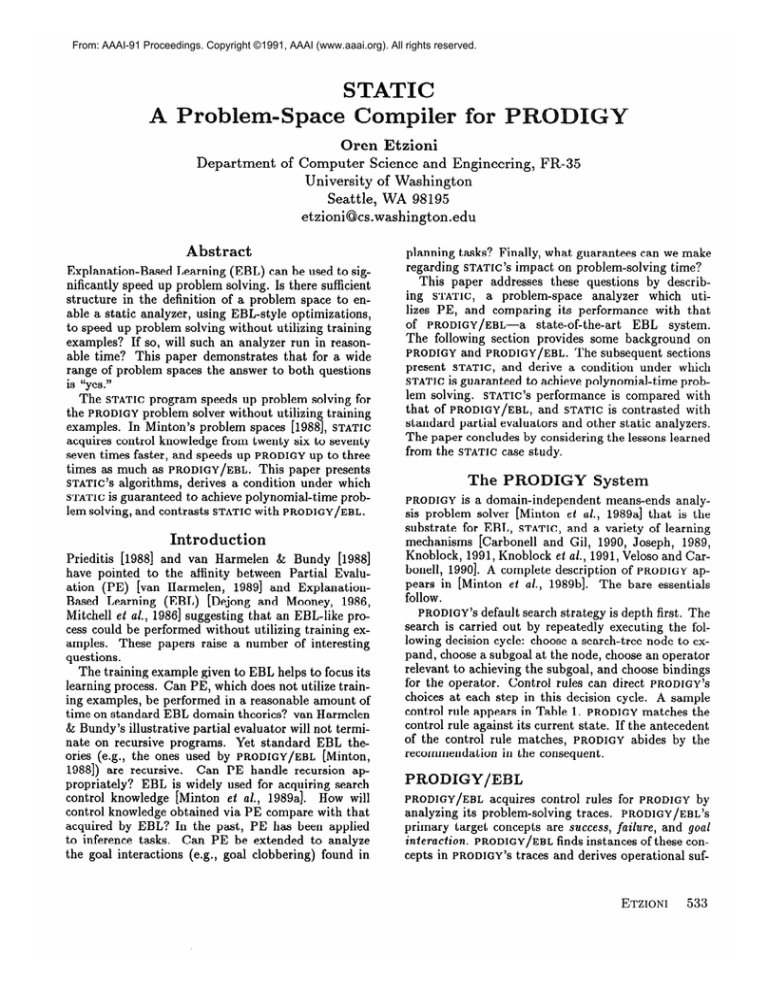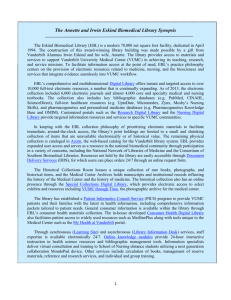
From: AAAI-91 Proceedings. Copyright ©1991, AAAI (www.aaai.org). All rights reserved.
STATIC
ace
Department
Oren Etzioni
of Computer Science and Engineering,
University of Washington
Seattle, WA 98195
etzioni@cs.washington.edu
Abstract
Explanation-Based
Learning (EBL) can be used to significantly speed up problem solving. Is there sufficient
structure
in the definition
of a problem space to enable a static analyzer, using EBL-style optimizations,
to speed up problem solving without utilizing training
examples?
If so, will such an analyzer run in reasonable time? This paper demonstrates
that for a wide
range of problem spaces the answer to both questions
is “yes .”
The STATIC program speeds up problem solving for
the PRODIGY problem solver without utilizin
training
examples.
In Minton’s problem spaces [1988s , STATIC
acquires control knowledge from twenty six to seventy
seven times faster, and speeds up PRODIGY up to three
times as much as PRODIGY/EBL. This paper presents
STATIC'S algorithms,
derives a condition
under which
STATIC is guaranteed
to achieve polynomial-time
problem solving, and contrasts STATIC with PRODIGY/EBL.
Introduction
Prieditis
[19SS] and van Harmelen
& Bundy [1988]
have pointed
to the affinity between Partial
Evaluation (PE) [van Harmelen,
19891 and ExplanationBased Learning
(EBL) [Dejong and Mooney,
1986,
Mitchell et al., 19861 suggesting
that an EBL-like process could be performed without utilizing training examples.
These papers raise a number of interesting
questions.
The training example given to EBL helps to focus its
learning process. Can PE, which does not utilize training examples, be performed in a reasonable
amount of
time on standard EBL domain theories? van Harmelen
& Bundy’s illustrative
partial evaluator will not terminate on recursive programs.
Yet standard
EBL theories (e.g., the ones used by PRODIGY/EBL
[Minton,
19881) are recursive.
Can PE handle recursion
appropriately?
EBL is widely used for acquiring search
control knowledge
[Minton et al., 1989a].
How will
control knowledge obtained via PE compare with that
acquired by EBL? In the past, PE has been applied
to inference tasks.
Can PE be extended
to analyze
the goal interactions
(e.g., goal clobbering)
found in
FR-35
planning tasks? Finally, what guarantees
can we make
regarding STATIC'S impact on problem-solving
time?
This paper addresses
these questions
by describanalyzer
which utiing STATIC, a problem-space
lizes PE, and comparing
its performance
with that
state-of-the-art
EBL system.
of PRODIGY/EBL-a
The following section provides some background
on
PRODIGY and PRODIGY/EBL. The subsequent
sections
present STATIC, and derive a condition
under which
STATIC is guaranteed
to achieve polynomial-time
problem solving.
STATIC's performance
is compared
with
that of PRODIGY/EBL, and STATIC is contrasted
with
standard partial evaluators
and other static analyzers.
The paper concludes by considering the lessons learned
from the STATIC case study.
The
G-Y
System
PRODIGY is a domain-independent
means-ends
analysis problem solver [Minton et al., 1989a] that is the
substrate
for EBL, STATIC, and a variety of learning
mechanisms
[Carbonell
and Gil, 1990, Joseph, 1989,
Knoblock, 1991, Knoblock et al., 1991, Veloso and Carbonell, 19901. A complete description
of PRODIGY appears in [Minton et al., 1989131. The bare essentials
follow.
PRODIGY'S default search strategy is depth first. The
search is carried out by repeatedly
executing
the following decision cycle: choose a search-tree node to expand, choose a subgoal at the node, choose an operator
relevant to achieving the subgoal, and choose bindings
for the operator.
Control rules can direct PRODIGY'S
choices at each step in this decision cycle. A sample
control rule appears in Table 1. PRODIGY matches the
control rule against its current state. If the antecedent
of the control rule matches,
PRODIGY abides by the
recommendation
in the consequent.
RODIGY/EBL
acquires control rules for PRODIGY by
analyzing its problem-solving
traces. PRODIGY/EBL'S
primary target concepts are success, failure, and goal
interaction.
PRODIGY/EBL finds instances of these concepts in PRODIGY'S traces and derives operational
sufPRODIGY/EBL
ETZIONI
533
(REJECT-UNSTACK
(if
(and (current-node
25)
(current-goal
N (holding
Block))
(candidat
e-op N unstack)
(known N (not (on Block Blck2)))))
(then
(reject
operator
unstack)))
Table 1: A Blocksworld
control rule telling PRODIGY
to reject the operator UNSTACK when the block to be
unstacked is not on any other block.
ficient conditions for the concepts via EBL. These conditions become the antecedents
ofPRODIGY /EBL'Scontrol rules and the target concept determines
the recommendation
expressed in the consequent
of the rule.
The rule in Table 1, for example, is formed by analyzing the failure of the Blocksworld operator UNSTACK.
STATIC
STATIC is a program
that
acquires
search
conanalyztrol knowledge
for PRODIGY by statically
ing PRODIGY'S problem
space definitions.
Like
PRODIGY/EBL, STATIC analyzes success, failure and
goal interaction.
Unlike PRODIGY/EBL, STATIC only
learns from nonrecursive
explanations
and does not
require training
examples,
utility evaluation,
or rule
compression.
This paper reviews briefly STATIC'Sgraph representation and algorithms
for analyzin
failure and success (introduced
in [Etzioni,
1990b ‘5) and focuses on
STATIC'Salgorithms for analyzing goal interaction
and
on a detailed comparison
with PRODIGY/EBL?
The
main new result presented is a comparison
of the time
required
to generate
control knowledge
via STATIC
with the time required
to train PRODIGY/EBL. In
PRODIGY/EBL,S problem spaces,s~~~~~generates control knowledge from twenty six to seventy seven times
faster than PRODIGY/EBL.
STATIC'sinput is a problem space definition; its output is a set of control rules that are intended to speed
up PRODIGY 'Sproblem solving. STATIC'Soperation can
be divided into four phases. First, it maps the problem space definition to a set of Problem Space Graphs
(PSGs), one for each potential
subgoal.2
Second, it
labels each PSG node and computes
the conditions
under which subgoaling
or back-chaining
on the node
would lead to failure.
Third, it creates control rules
whose antecedents
are composed of these conditions
(or their negation).
The rules guide PRODIGY'S opera'STATICwas introduced (in approximately
one page) in
[Etzioni, 199Ob]to demonstrate
PRODIGY/EBL,Sreliance on
nonrecursive
problem space structure.
2A potential
subgoal is an uninstantiated
literal found
in the effects of an operator.
Potential
subgoals are enumerated by scanning the problem space definition.
534
LEARNING SEARCH CONTROL
tor and bindings choices. Finally, STATIC searches for
goal clobbering
and prerequisite
violation
by analyzing PSG pairs, and forms goal ordering and operator
preference rules based on this analysis.
Problem
Space
Graphs
(PSGs)
A PSG is an AND/OR graph that represents
the
goal/subgoal
relationships
in a problem space. STATIC
constructs
PSGs by partially
evaluating
the problem
space definition;
PSGs are independent
of any state
information.
This section describes PSGs in more detail. A pseudo-code
description
of STATIC'Salgorithm
for constructing
PSGs appears in Table 2.
A PSG consists of disjoint subgraphs
each of which
is rooted in a distinct subgoal literal. Each subgraph
is derived by symbolically
back chaining on the problem space’s operators from the root. The root literal
is connected
via o&links
to all the operators
whose
effects match the literal, and each operator
is connected via AND-linksto itspreconditions.
Thus, the
PSG nodes are an alternating
sequence of (sub)goals
and operators;
the PSG edges are either AND-linksor
OR-links.Figure 1 depicts the Blocksworld
PSG subgraph rooted in (holding
V). The graph is directed
and acyclic. Two operators that share a precondition
have AND-linksto the same node, so the graph isnot
a tree.
Figure
1: The holding
PSG.
A successful match between an operator’s effects and
a subgoal imposes codesignation
constraints
between
the arguments
to the subgoal literal, and the operator’s variables.
The operator’s
preconditions
are partially instantiated
to reflect these constraints.
For example, since the goal is (holding
V), UNSTACK'S first
precondition
is partially instantiated
to (on V V2).
The expansion of the graph is terminated
under welldefined criteria discussed in [Etzioni, 1990b]. The most
important
criterion is the termination
of PSG expansion whenever predicate repetition
(on a path from a
node to the root)isdetected.This criterion
suffices
to
prove that every PSG is finite [Etzioni, 199Oa].
Input: operators,
constraints
on legal states,
uninstantiated
goal literal g.
Output: A PSG for g (e.g., Table 1).
and a
The goal stack of a node 12 in the PSG, goal-stacb(n),
is the unique set of subgoal nodes on a path from n
to the root.
The function
holds(p,goaZ-slaclc(p))
determines whether the precondition
p necessarily holds
given its goal stack and the constraints
on legal states.
o&g) refers to the set of operators that can potentially
achieve g.
Algorithm:
1. Create
a subgoal
node for g.
2. For each operator
o E ops(g):
(a) Partially instantiate
(b) Create an operator
0 to og.
node for og and OR-link it to
(c) ;f any of og ‘s preconditions
appears on its goal
stack, then create a subgoal node corresponding
to that precondition,
label it gs-cycle, and ANDlink it to og.
(d) Else, for each precondition
p E precs(o,):
i. If a previously expanded sibling operator shares
p, then a node for p already exists. AND-link og
to the existing node.
ii. Otherwise,
create a new node p and AND-link it
to og.
iii. If hoZds(p, (goal-stack(p))
then label p holds.
iv. If p’s predicate appears on og’s goal stack, then
label p unknown (i.e. recursion could occur here).
v. If no operator matches p, then label p unachievable.
vi. Else, return
goal g.
Table
to step 1 with p as the current
2: Constructing
sub-
a PSG.
Having constructed
a set of PSGs corresponding
to a
problem space, STATIC proceeds to label each internal
node in the PSGs with one of the labels failure, success, or unknown indicating
the eventual outcome of
problem solving when PRODIGY reaches a corresponding node in its search. The labeling is performed using
a three-valued
“label logic” where the label of an operator node is the conjunction
of its preconditions’
labels
and the label of a precondition
node is the disjunction
of the labels of the operators
whose effects match the
precondition.
PRODIGY control rules that guide operator and bindings choices are constructed
based on this
labeling process. See [Etzioni, 1990a] for more details.
yzing
Goal Inkractions
in STATIC
Goal interactions
such as goal clobbering
and prerequisite violation cause PRODIGY to backtrack.
STATIC
anticipates
these goal interactions
by analyzing
PSG
pairs, and generates goal ordering and operator preference control rules that enable PRODIGY to avoid goal
interactions.
STATIC is not cona$eZe in that it will not
anticipate all possible goal interactions,
but it is correct
in that the interactions
that STATIC anticipates
would
in fact occur, if it were not for STATIC'S control rules.
STATIC anticipates
goal interactions
that will necessarily occur. That is, STATIC reports that two goals
interact,
under certain constraints,
only if the goals
interact in every state that obeys the constraints.
An
alternative
o timization strategy (taken by Knoblock’s
Alpine [1991 P, for example) is to anticipate possible goal
interactions.
While STATIC analyzes
both goal clobbering
and
prerequisite
violation,
this section considers only goal
clobbering.
The section begins by formally defining
The section then presents STATIC’S
goal clobbering.
algorithm
for anticipating
goal clobbering
by analyzing PSGs.
Two important
simplifications
are made
in the presentation
for the sake of brevity and clarity. First, the presentation
is restricted
to propositional goals even though STATIC actually analyzes variablized goals and codesignation
constraints
between
them.
Second, although
necessary
goal interactions
are sometimes
“conditional”
(that is, occur necessarily only when the set of possible states is constrained
appropriately)
the discussion
does not describe how
STATIC derives these constraints.
See [Etzioni, 199Oa]
for a complete discussion.
A plan for achieving a goal g is said to clobber a protected goal pg when pg is deleted in the process of executing the plan. In Minton’s machine-shop
scheduling
problem space (the Schedworld),
for example, punching a hole through an object damages any polish on
Thus, the goal of having a polthe object’s surface.
ished surface is clobbered by punching a hole through
the object.
The notation g]s denotes that the subgoal g holds in
the state s, and c(s) denotes the state that results from
applying the operator sequence c to the state s. The
notation
OC(g,pg) d enotes that the goal g necessarily
clobbers the protected goal pg.
OC(9,P9)5 Vs s.t. pgls, and Vc s.t. SW>,
we have that
lpglc(s).
Let E(9,p9) denote the necessary effects of achieving
the subgoal g from any state in which the protected
subgoal pg holds. The necessary effects are the set of
literals that necessarily hold in the current state after
g is achieved by an arbitrary
plan from any state in
which pg holds.
E(g,pg)
= {e] V’s s.t. pg(s, and Vc s.t. gjc(s),
we have that e/c(s)}
ETZIONI
535
E(g,pg)
is precisely the set of interest when considering whether one goal will clobber another. g clobbers
pg if and only if pg is negated as a necessary effect of
achieving g .
Lemma
1
qC(g,pg)
ifl3e
E E(g, pg) s.t. e 3
-pg.3
STATIC anticipates
goal interactions
by computing
a subset of of E(g,pg)
denoted by g(g).
The necessary effects of achieving a goal are the necessary effects shared by all the operators that could potentially
achieved the goal. The necessary effects (computed
by
STATIC) of an operator
o that achieves g are denoted
bY fro(9).
E($)=
f-j
fiolg).
oEops(9)
Thus, a goal is always one of its necessary effects (i.e.
Vg, we have that g E Z?(g)). The necessary effects of
an operator are, in essence, the union of its effects and
the necessary effects of its preconditions.
When two
effects are potentially
contradictory
only the one that
would occur later during problem solving is retained.
JQo(9) =
1 1
U
l?(p)
U e$ecis(o).
pEprecs(0)
STATIC'S computation
Theorem
is correct.
That
is,
1 i?(g) C E(g,pg).
Experimental
Methodology
In his thesis [1988], Minton tested PRODIGY/EBL
on
one hundred
randomly
generated
problems
in three
problem spaces (the Blocksworld,
an extended version
of the STRIPS problem space [Fikes et al., 19721, and
a machine-shop
scheduling problem space) and showed
is able to significantly
speed up
that PRODIGY/EBL
PRODIGY. These problem spaces, as well as a modified
version of the Blocksworld (the ABworld) constructed
to foil PRODIGY/EBL,
are used to compare
STATIC
and PRODIGY/EBL.
PRODIGY
is run on Minton’s
test-problem
sets under three experimental
conditions:
guided by no control rules, guided by PRODIGY/EBL'S
rules, and guided by STATIC'S rules. A bound of 150
CPU seconds was imposed on the solution time for
each problem.
The times reported below are slightly
smaller than the times in [Etzioni, 1990b] due to minor
improvements
to the systems involved.
Impact
4 demonstrates,
STATIC is able to speed up
more than PRODIGY/EBL in each of Minton’s
problem spaces and in the ABworld.
This section reports on problem-solving
time, number of nodes expanded, and average time to expand a node. No significant differences were found in the length of the solutions produced by the systems. Since neither system
attempts to reduce solution length, this is not surprising.
PRODIGY
N)
V2 cylindrical)))
N (shape
N (surface
V2 polished)))
goal (shape
V2 cylindrical)
(surface
V2 polished)))
Table 3: A goal ordering
rule produced
Comparing STATIC
PRODIGY/EBL
This section compares
the impact,
generate
control
knowledge,
and
by STATIC.
with
time required to
scope of STATIC
3Proofs of the results are in [Etzioni, 199Oa].
536
Although
STATIC outperforms
problem
spaces studied,
this
will not always be the case. PRODIGY/EBL
can exploit the distribution
of problems
encountered
by
PRODIGY whereas STATIC cannot
and, unlike STATIC,
PRODIGY/EBL
can be guided by a carefully chosen
training-example
sequence.
As Table
To illustrate
the algorithm’s
operation
consider the
Schedworld
goal (shape
Obj cylindrical).
Only
two operators can potentially
achieve this goal: LATHE
and ROLL. Both operators
delete the surface condition of the object they are applied to. As a result,
achieving (shape
Obj cylindrical)
necessarily clobbers (surf ace Obj polished).
STATIC detects this
necessary side-effect by intersecting
&lathe and &oll.
The rule formed based on the analysis appears in Table 3.
(PREFER-SHAPE
(if (and
(current-node
(candidate-goal
(candidate-goal
(then
(prefer
and PRODIGY/EBL.~
PRODIGY/EBL
in the
LEARNING SEARCH CONTROL
Table 4: Total problem-solving
time in CPU seconds. In the Schedworld,
STATIC was unable to solve
one problem within the 150-CPU second time bound
and
compared with eight problems for PRODICY/EBL
twenty three for PRODIGY.
expanded
The
total
number
of
nodes
by PRODIGY/EBL and STATIC is fairly close, compared
with the number of nodes expanded by PRODIGY given
41t is important
to note that PRODIGY/EBL predates
STATIC is based on an
STATIC by several years and that
in-depth study of PRODIGY/EBL.
no control rules (Table 5). The number of nodes expanded indicates the ability of each system to curtail
PRODIGY'S search.
As the table shows, STATIC actually expanded
more nodes than PRODIGY/EBL
in the
Blocksworld and the Stripsworld.
Since STATIC'S rules
are cheaper-to-match
than PRODIGY/EBL'S (Table 6),
however, STATIC'S overall search time was consistently
lower than PRODIGY/EBL'S. STATIC'S rules are relatively cheap-to-match
for two reasons.
First, STATIC
does not learn from recursive explanations
which tend
to yield control rules that are both more specific and
more expensive-to-match
than their nonrecursive
counterparts.
Second, PRODIGY/EBL'S control rules often
retain incidental features of its training examples that
do not appear in STATIC'S rules. Although
EBL only
retains the aspects of its training
example that appear in the weakest preconditions
of its explanation,
often there is a large set of possible explanations
associated with any example, explanations
whose weakest
preconditions
differ greatly. Frequently,
STATIC'S “explanations”
are more compact than those produced by
PRODIGY/EBL even when both are nonrecursive.
Table 7: Learning
time in CPU seconds.
PRODIGY/EBL'S running
time into three
decomposes
components:
time to solve training
examples,
time
to construct
proofs based on the training
examples’
traces, and time to perform utility evaluation.
It’s interesting to note that utility evaluation
is quite costly,
and that STATIC'S total running
time is consistently
smaller than PRODIGY/EBL'S proof construction
time.
1 ABworld
2493 I
I
8067 1
673 1
Table 8: PRODIGY/EBL'S learning
time decomposed
into components:
time to solve training examples, time
to construct proofs based on the problem-solving
trace,
and time to perform utility evaluation.
so much
faster
than
traverses
the PSGs for
the problem space, whereas PRODIGY/EBL
traverses
PRODIGY'S problem solving trace for each of the trainconsists of
ing examples.
Since STATIC's processing
several traversals over its PSGs (construction,
labeling, analysis of necessary
effects, etc.), its running
time is close to linear in the number of nodes in its
PSGs. Since PRODIGY/EBL analyzes PRODIGY'S traces,
it learning time scales with the number of nodes in
PRODIGY's traces.
We can predict,
therefore,
that
the number of trace nodes visited by PRODIGY/EBL
is much larger than the number of nodes in STATIC'S
PSGs.
Table 9 confirms this prediction.
In fact,
the ratio of trace nodes to PSG nodes is almost perfectly correlated
(correlation=0.999)
with the ratio of
Why
Table
5: Total
number
of nodes expanded.
Table 6: Average CPU seconds per node.
The center and right columns reflect the cost of matching
PRODIGY/EBL
and STATIC'S rule sets respectively.
Cost of Learning
The time required
for learning
is an important
aspect of a learning method because, when learning time
scales badly with problem size, learning can become
prohibitively
expensive
on problems
of interest.
In
the problem spaces studied, STATIC was able to generate control knowledge
twenty six to four hundred
and sixty three times faster than PRODIGY/EBL.
Table 7 compares the learning time for the two systems.
PRODIGY/EBL was “trained”
by following the learning
procedure outlined in Minton’s thesis.
PRODIGY/EBL'S learning
time includes the time required to solve the training examples whose problemsolving traces are analyzed by PRODIGY/EBL. Table 8
did
PRODIGY/EBL?
PRODIGY/EBL's
STATIC run
STATIC
n.KIninghrM? t0 STATIC'%
Table 9: PSG nodes versus trace nodes.
It is reasonable to believe, therefore, that STATIC will
continue to be significantly
faster than PRODIGY/EBL
when the ratio between
trace size, summed
over
PRODIGY/EBL'S training
examples,
and PSG size reETZIONI
537
mains large. PSGs are more compact than traces because the PSGs are partially instantiated,
and because
they do not contain nodes corresponding
to recursive
expansions.
Scope
STATIC utilizes
target
concepts
based on those in
PRODIGY/EBL, but only learns from nonrecursive
explanations.
Thus, STATIC will not acquire control
knowledge that can only be learned from recursive explanations.
Fortunately
for STATIC, the knowledge required to control search in the problem spaces studied
can usually be derived from nonrecursive
explanations
using STATIC'S target concepts.
The target concepts
can frequently explain PRODIGY'S behavior in multiple
ways, some of which are recursive and some of which
are not. PRODIGY/EBL acquires control rules from each
of these explanations
causing it to generate redundant
STATIC'S more conservative
policy
control knowledge.
of only learning from nonrecursive
explanations
is advantageous in this case; STATIC learns fewer redundant
rules than PRODIGY/EBL.
Because it performs static analysis,
the range of
proofs utilized by STATIC is narrower
than that of
PRODIGY/EBL.
STATIC does not analyze
state cycles for example,
because, in contrast
to PRODIGY'S
trace, no unique world state is associated
with the
PSG’s nodes.
Thus, merely detecting potential
state
cycles would be more difficult for STATIC than for
PRODIGY/EBL.
STATIC only analyzes
binary goal interactions
as opposed to N-ary ones. The decision to analyze binary
goal htf?raCtiOnSk aW%IOgOUS t0 STATIC'S POky Of analyzing only nonrecursive
explanations.
In both cases
additional
coverage can be obtained
by analyzing
a
broader class of explanations,
but STATIC chooses to
focus on the narrower class to curtail the costs of acquiring and utilizing control knowledge.
In the problem spaces studied, STATIC acquires more effective control knowledge than PRODIGY/EBL
despite (or, perhaps, due to) STATIC'S narrower scope.
slynomial-Time
Problem
Solving
By definition,
polynomial-time
problem solving can
only be achieved for problem spaces that are in the
complexity
class P. No learning method will work for
all problems in P, because finding a polynomial-time
algorithm
for an arbitrary
problem in P is undecidable. A distribution-free
sufficient condition
for the
success of STATIC (and EBL) can be derived, however,
based on the notion of a fortuitous recursion.
A recursion is said to be fortuitous
when any plan that
contains the recursion will succeed if the nonrecursive
portion of the plan succeeds. When all problem-space
recursions
are fortuitous,
nonrecursive
proofs of failure suffice to eliminate
backtracking,
and STATIC can
achieve polynomial- time problem solving.
538
LEARNING
SEARCH CONTROL
Three additional definitions are required to state this
idea precisely. Let a Datalog problem solver be a problem solver whose operator preconditions
and effects are
restricted
to Datalog literals.5
A goal interaction
between two subgoals is said to be binary when it occurs
independent
of other subgoals.
A goal interaction
is
said to be nonrecursive
if it can be detected using a
nonrecursive
proof.
Theorem 2 STATIC will achieve
polynomial-time
problem solving for a Datalog problem solver when:
1. All recursions
are fortuitous.
2. All goal interactions
3. Solution
are binary
length is polynomial
and nonrecursive.
in state size.
When the above conditions
hold in a given problem
space, STATIC'S exhaustive generation
of “nonrecursive
control knowledge”
guarantees
that it will eliminate
backtracking.
Since, by assumption,
solution length is
polynomial
in state size, it follows that no more than
a polynomial
number of search-tree
nodes will be expanded.
Since the cost of matching
STATIC'S control
knowledge at each node is polynomial
in the state size
(see [Etzioni, 1990a, Chapter 3]), STATIC will achieve
polynomial-time
problem solving.
EBL will achieve
polynomial-time
problem solving when it has the appropriate target concepts (failure and goal interaction)
and it encounters
the appropriate
training
examples;
namely, the ones that enable EBL to eliminate
backtracking using nonrecursive
proofs.
elated Work
Although
STATIC utilizes
partial
evaluation
to construct its PSGs, STATIC goes beyond standard
partial
evaluators
in several important
ways. First, STATIC
analyzes failure and goal interaction
whereas standard
partial evaluators
do not. Second, STATIC derives various subgoal reordering rules from this analysis.
Such
reordering
transformations
are not part of the usual
arsenal of partial evaluators.
Third, STATIC introduces
a novel criterion for choosing between multiple target
concepts:
In the absence of knowledge about problem
distribution,
learn only from the target concepts that
addresses the
yield nonrecursive
proofs. This criterion
problem of recursive explanations
for STATIC, a topic of
active research for the PE community
[van Harmelen,
1989, Sestfot, 19881.
do not anaUnlike STATIC, most partial evaluators
lyze goal interactions.
The remainder
of this section
compares STATIC with other problem space analyzers
that do attempt
to anticipate
and avoid goal interactions.
5Datalog is the function and negation free subset of pure
Prolog [Ullman,
19891.
A Datalog problem solver represents a slight idealization
of the PRODIGY problem solver.
REFLECT
Dawson
and
Siklossy
[1977] describe
engaged in static probran in two phases:
a
preprocessing
phase in which conjunctive
goals were
analyzed and macro-operators
were built followed by
a problem-solving
phase in which REFLECT engaged
in a form of backward-chaining.
During its preprocessing phase REFLECT analyzed
operators
to determine which pairs of achievable literals (e.g., (holding
were incompatible.
This was deterX) D (arm-empty))
mined by symbolically
backward-chaining
on the operators up to a given depth bound.
A graph representation,
referred to as a goal-kernel graph, was constructed in the process. The nodes of the goal-kernel
graph represent sets of states, and its edges represent
operators.
REFLECT also constructed
macro-operators
that at least one
using heuristics
such as “requiring
variable in both operators correspond
at all times.”
Although
the actual algorithms
employed by REFLECT and STATIC are different,
the spirit of STATIC
is foreshadowed
by this early system.
In particular,
STATIC'S PSG is reminiscent
of the goal-kernel graph,
both systems analyze successful paths, and both system analyze pairs of achievable
literals.
One of the
momain advances found in STATIC is its theoretically
tivated and well-defined
criteria for terminating
symbolic back-chaining,
particularly
its avoidance of reAnother advance is the formal specification
cursion.
and computation
of necessary effects and prerequisites
to facilitate
goal reordering.
Finally, unlike STATIC,
REFLECT does not actually
reorder goals.
REFLECT
merely terminates
backward-chaining
when an incompatible set of goals is reached.
REFLECT, an early system that
REFLECT
lem space analysis.
INE
Knoblock’s ALPINE [1991] generates hierarchies of abstract problem spaces by statically analyzing goal interactions.
ALPINE maps the problem space
definition to a graph representation
in which a node is
a literal, and an edge from one literal to another means
that the first literal can potentially
interact with the
former. Knoblock’s
guarantees
on ALPINE'S behavior
are analogous to my own: I compute a subset of the
necessary goal interactions,
and Knoblock computes a
superset of the possible goal interactions.
Both algorithms are correct and conservative.
The ABSOLVER
system [Mostow and Prieditis,
19891 contains a transformation
that computes
a superset of possible goal
interactions
as well.
Schoppers [19891 derives “univerUniversal Plans
sal plans” from problem space descriptions.
Universal
plans are, essentially,
sets of rules that tell an agent
what to do in any given state. Schoppers partially evaluates the problem space definition to derive universal
plans. Like STATIC, Schoppers only considers pairwise
goal interactions.
Unlike STATIC, he ignores the issues
of recursion and binding-analysis
for partially instantiated goals by only considering
tightly circumscribed
problem spaces such as the S-block Blocksworld where
recursion is bounded and variables are fully instantiated. Instead,
Schoppers focuses on handling
conditional effects, nonlinear
planning,
and incorrect world
models.
ethods
Whereas
STATIC anrobIem-Specific
alyzes the problem space definition,
some algorithms
analyze individual
problems.
Whereas STATIC is only
run once per problem space, the algorithms
described
below are run anew for each problem.
Since the algorithms use problem-specific
information,
they are often
able to make strong complexity and completeness
guarantees presenting
a tradeoff between
problem-space
analysis and problem-specific
analysis.
This tradeoff
has not been studied systematically.
Chapman’s
TWEAK
119871 utilizes an algorithm
for
determining
the necessary/possible
effects of a parThe input to the algorithm
is
tially specified plan.
an initial state and the plan. The output of the algorithm is a list of the plan’s necessary (occurring
in
all completions
of the plan) and possible (occurring
in some completion
of the plan) effects.
The algorithm runs in time that is polynomial
in the number
of steps in the plan. Cheng and Irani [1989] describe
an algorithm that, given a goal conjunction,
computes
a partial order on the subgoals in the goal conjunction. If a problem solver attacks the problem’s subgoals according to the specified order, it will not have
to backtrack
across subgoals.
The algorithm
runs in
O(n3) time where n is the number of subgoals.
FiALPINE performs
some initial prenally, Knoblock’s
processing
of the problem space definition,
but then
develops considerably
stronger constraints
on possible
goal interactions
by analyzing individual
problems.
Conclusion
This paper addresses the questions posed at the outset by means of a case study.
Partial evaluation
ah-STATIC can be performed
in reasonable
time on
PRODIGY/EBL'S domain theories.
The problem of recursion is overcome by learning only from nonrecursive
explanations
utilizing multiple target concepts.
The
control knowledge
derived by STATIC is better than
that acquired by PRODIGY/EBL, and was generated
considerably
faster. Finally, STATIC'S analysis of goal
interactions
demonstrates
that partial evaluation
can
be applied to planning as well as inference tasks.
As the previous section indicates, STATIC is only one
point in the space of static problem space analyzers.
Consider Knoblock’s ALPINE [1991] as a point of contrast. STATIC is run once per problem space whereas
ALPINE preprocesses
individual problems.
STATIC analyzes necessary goal interactions
whereas ALPINE analyzes possible goal interactions.
STATIC outputs control
rules whereas ALPINE outputs abstraction
hierarchies.
The differences between the two systems suggest that
the space of static analyzers is large and diverse. The
ETZIONI
539
demonstrated
success of the two systems indicates the
potential of static problem space analysis as a tool for
deriving control knowledge.
Ultimately,
this success
is not surprising.
Powerful optimizing
compilers have
been developed for most widely-used programming
languages. There is no reason to believe that problemspace-specification
languages will be an exception.
Acknowledgments
This paper describes
research done primarily
at
Carnegie Mellon University’s
School of Computer
Science. The author was supported
by an AT&T Bell
Thanks go to the author’s
Labs Ph.D. Scholarship.
advisor, Tom Mitchell, and the members of his thesis committee,
Jaime Carbonell,
Paul Rosenbloom,
and Kurt VanLehn for their contributions
to the ideas
herein. Special thanks go to Steve Minton-whose
thesis work made studying,PRODIGY/EBL
possible, and to
Ruth Etzioni for her insightful comments.
eferences
Carbonell,
mentation:
J. G. and Gil, Y. 1990. Learning by experiThe operator refinement
method. In Ma-
chine Learning,
An Artificial
Volume III. Morgan Kaufman,
Intelligence
Approach,
San Mateo, CA. 191213.
Planning
for conjunctive
Chapman,
David 1987.
goals. Artificial Intelligence 32(3):333-378.
Cheng, Jie and Irani, Keki B. 1989. Ordering problem
subgoals. In Proceedings of the Eleventh International
Joint Conference
on Artificial Intelligence,
Detroit,
Michigan. Morgan Kaufmann.
931-936.
Dawson, Clive and Siklossy, Laurent 1977. The role
of preprocessing
in problem-solving
systems. In Proceedings of the Fifth International
on Artificial Intelligence.
Joint
Conference
Dejong, G. F. and Mooney, R. J. 1986. Explanationbased learning:
An alternative
view. Machine Learning l(1).
A Structural
Theory
of
Etzioni,
Oren
1990a.
Ph.D. Dissertation,
Explanation-Based
Learning.
Carnegie Mellon University.
Available
as technical
report CMU-CS-90-185.
Etzioni, Oren 1990b. Why Prodigy/EBL
works. In
Proceedings of the Eighth National
tificial Intelligence.
Conference
on Ar-
Fikes, R.; Hart, P.; and Nilsson, N. 1972. Learning
and executing generalized
robot plans. Artificial Intelligence
3(4).
Joseph, Robert L. 1989. Graphical knowledge
tion. In Proceedings of the Fourth Knowledge
tion For Knowledge-Based
Systems
Workshop,
acquisiAcquisi-
Banff,
Canada.
Knoblock,
Craig; Minton, Steve; and Etzioni, Oren
1991. Integrating
abstraction
and explanation-based
learning in prodigy. In Proceedings of the Ninth National Conference
540
on Artificial
Intelligence.
LEARNING SEARCH CONTROL
Knoblock,
Craig
Abstractions
Carnegie
A. 1991.
for Problem
Mellon
Automatically
Generating
Solving. Ph.D. Dissertation,
University.
Minton,
Steven;
Carbonell,
Jaime G.; Knoblock,
Craig A.; Kuokka,
Daniel R.; Etzioni,
Oren; and
Gil, Yolanda 1989a. Explanation-based
learning:
A
problem-solving
perspective.
Artificial Intelligence
40:63-l 18. Available
as techincal
report CMU-CS89-103.
Minton,
Steven;
Knoblock,
Craig
A.;
Kuokka,
Daniel R.; Gil, Yolanda; Joseph, Robert L.; and Carbonell, Jaime G. 1989b. Prodigy 2.0: The manual and
tutorial. Technical Report CMU-CS-89-146,
Carnegie
Mellon University.
Minton,
Steven
trol Knolwedge:
1988. Learning
An
Ph.D.
Dissertation,
Available as technical
Eflective
Explanation-Based
Search ConApproach.
Carnegie
Mellon
University.
report CMU-CS-88-133.
Mitchell, Tom M.; Keller, Rich;
Smadar 1986. Explanation-based
unifying view. Machine Learning
Mostow, Jack and Prieditis,
covering admissible heuristics
timizing:
a transformational
and Kedar-Cabelli,
generalization:
A
l(1).
Armand E. 1989. Disby abstracting
and opapproach.
In Proceed-
ings of the Eleventh International
on Artificial Intelligence.
Joint
Conference
Prieditis,
A. E. 1988. Environment-guided
program
transformation.
In Proceedings of the AAAI Spring
Symposium
on Explanation-Based
Learning.
1989. Representation
and
Plans. Ph.D. Dissertation, University
of Illinois at Urbana-Champaign.
Available as technical report UIUCDCS-R-89-1546.
Schoppers,
Marcel Joachim
Automatic
Synthesis
of Reaction
Sestfot, Peter 1988. Automatic
call unfolding
in a
partial evaluator.
In Bjorner,
D.; Ershov, A. P.;
and Jones, N. D., editors 1988, Partial Evaluation
Elsevier Science Publishers.
and Mixed Computation.
Workshop Proceedings.
Ullman,
Jeffrey D. 1989. Database and Knowledgevolume I. computer science press.
base systems,
van Harmelen,
Frank
and Bundy,
Alan
1988.
Explanation-based
generalisation
= partial evaluation. Artificial Intelligence 36. Research Note.
van Harmelen,
Frank 1989. The limitations
of partial evaluation.
In Logic-Based Knowledge Representation. MIT Press, Cambridge,
MA. 87-112.
Veloso, Manuela M. and Carbonell,
Jaime G. 1990.
Integrating
analogy into a general problem-solving
architecture. In Intelligent Systems. Ellis Horwood Limited.







